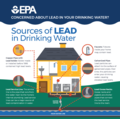Lead and Copper Rule
Lead and Copper Rule (LCR) is a United States federal regulation that limits the concentration of lead and copper allowed in public drinking water at the consumer's tap, as well as limiting the permissible amount of pipe corrosion occurring due to the water itself. The rule is part of the Safe Drinking Water Act (SDWA) and is enforced by the United States Environmental Protection Agency (EPA). The LCR was first enacted in 1991 and has undergone various amendments to better protect public health.
Background[edit]
Lead and copper are both common metals that can be found in plumbing materials and water service lines. While both elements have various industrial and electrical applications, they can be toxic to humans and animals when ingested. Lead is particularly harmful to children, causing developmental delays and neurological problems. Copper, while necessary for human health in small amounts, can cause gastrointestinal distress and liver or kidney damage when consumed in large quantities.
Regulatory Limits[edit]
The Lead and Copper Rule establishes action levels (AL) for lead and copper in drinking water. The action level for lead is set at 0.015 milligrams per liter (mg/L) and for copper at 1.3 mg/L. Water systems are required to take steps to reduce the concentration of these metals if more than 10% of tap water samples exceed these levels.
Compliance[edit]
To comply with the LCR, water systems must conduct regular monitoring of lead and copper levels at customer taps. If levels exceed the action limits, the system must undertake additional actions, including:
- Corrosion control treatment (CCT) to reduce the leaching of lead and copper into the water.
- Public education campaigns to inform consumers about the risks of lead and copper exposure and steps they can take to reduce their exposure.
- Lead service line replacement programs to remove lead-containing pipes from the water distribution system.
Amendments and Updates[edit]
The LCR has been amended several times since its initial enactment. Notable amendments include the Lead and Copper Rule Minor Revisions (LCRMR) in 2000, which clarified sampling and monitoring requirements, and the Lead and Copper Rule Revisions (LCRR) proposed in 2019, aiming to strengthen lead and copper testing protocols, improve risk communication, and accelerate lead service line replacements.
Controversies and Challenges[edit]
The effectiveness of the Lead and Copper Rule has been a subject of debate. Critics argue that the rule's reliance on action levels rather than maximum contaminant levels (MCLs) allows for a significant amount of lead and copper exposure before action is required. Incidents like the Flint Water Crisis have highlighted the potential for systemic failures and the need for stronger regulations and oversight.
See Also[edit]
References[edit]
<references/>
This environment-related article is a stub. You can help WikiMD by expanding it.
-
Sources of Lead in Drinking Water - EPA 2017
-
Lead in Drinking Water: How can the government provide better oversight?
Ad. Transform your life with W8MD's Budget GLP-1 injections from $75


W8MD offers a medical weight loss program to lose weight in Philadelphia. Our physician-supervised medical weight loss provides:
- Weight loss injections in NYC (generic and brand names):
- Zepbound / Mounjaro, Wegovy / Ozempic, Saxenda
- Most insurances accepted or discounted self-pay rates. We will obtain insurance prior authorizations if needed.
- Generic GLP1 weight loss injections from $75 for the starting dose.
- Also offer prescription weight loss medications including Phentermine, Qsymia, Diethylpropion, Contrave etc.
NYC weight loss doctor appointmentsNYC weight loss doctor appointments
Start your NYC weight loss journey today at our NYC medical weight loss and Philadelphia medical weight loss clinics.
- Call 718-946-5500 to lose weight in NYC or for medical weight loss in Philadelphia 215-676-2334.
- Tags:NYC medical weight loss, Philadelphia lose weight Zepbound NYC, Budget GLP1 weight loss injections, Wegovy Philadelphia, Wegovy NYC, Philadelphia medical weight loss, Brookly weight loss and Wegovy NYC
|
WikiMD's Wellness Encyclopedia |
| Let Food Be Thy Medicine Medicine Thy Food - Hippocrates |
Medical Disclaimer: WikiMD is not a substitute for professional medical advice. The information on WikiMD is provided as an information resource only, may be incorrect, outdated or misleading, and is not to be used or relied on for any diagnostic or treatment purposes. Please consult your health care provider before making any healthcare decisions or for guidance about a specific medical condition. WikiMD expressly disclaims responsibility, and shall have no liability, for any damages, loss, injury, or liability whatsoever suffered as a result of your reliance on the information contained in this site. By visiting this site you agree to the foregoing terms and conditions, which may from time to time be changed or supplemented by WikiMD. If you do not agree to the foregoing terms and conditions, you should not enter or use this site. See full disclaimer.
Credits:Most images are courtesy of Wikimedia commons, and templates, categories Wikipedia, licensed under CC BY SA or similar.
Translate this page: - East Asian
中文,
日本,
한국어,
South Asian
हिन्दी,
தமிழ்,
తెలుగు,
Urdu,
ಕನ್ನಡ,
Southeast Asian
Indonesian,
Vietnamese,
Thai,
မြန်မာဘာသာ,
বাংলা
European
español,
Deutsch,
français,
Greek,
português do Brasil,
polski,
română,
русский,
Nederlands,
norsk,
svenska,
suomi,
Italian
Middle Eastern & African
عربى,
Turkish,
Persian,
Hebrew,
Afrikaans,
isiZulu,
Kiswahili,
Other
Bulgarian,
Hungarian,
Czech,
Swedish,
മലയാളം,
मराठी,
ਪੰਜਾਬੀ,
ગુજરાતી,
Portuguese,
Ukrainian

